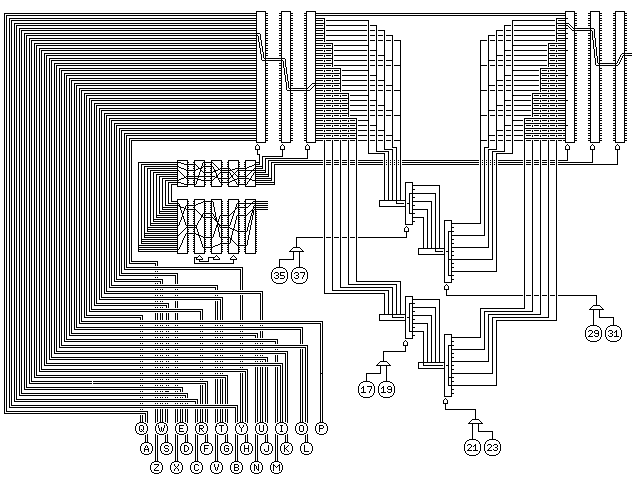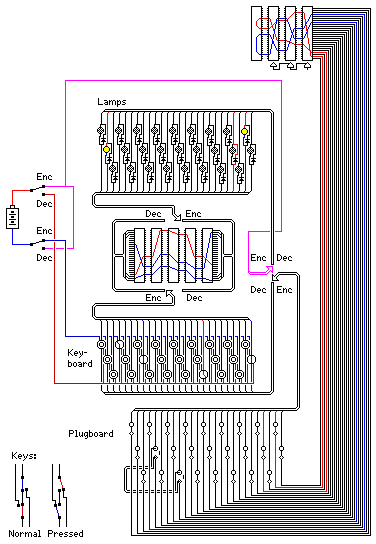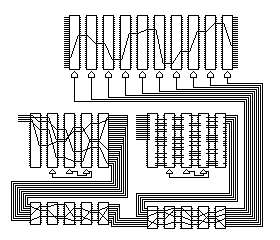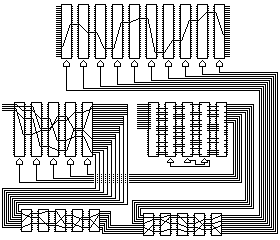
Of course, many different encryption principles have been seen in the devices covered in this chapter. One could imagine combining many of these techniques in a single elaborate device, such as the following:

The heart of this device is two pairs of two half rotors, each pair with one with five inputs and ten outputs and one with five inputs and fifteen outputs, as in the improved French version of the B-211.
The coordinates for each letter of the alphabet are varied by preceding and following that part of the device by three conventional rotors. Almost conventional, that is, since these rotors all have two duplicate concentric sets of wiring, so that each letter is connected to its home in both row and column. Note that since these rotors have 26 positions, one letter bypasses the B-21 -like part of the device.
And to top it all off, these six rotors are advanced by means of a SIGABA-like setup. Obviously too bulky and expensive to build out of real electromagnetic components, and yet fascinating.
Here is an example of an interesting rotor machine design using some of the ideas suggested by the design of the Uhr Box:

The arrangement for rotor motion is of interest. With each letter enciphered, a pinwheel is used to select whether rotor 2 or rotor 4 moves. Rotor 3 moves whenever a notch on either of those rotors is advanced, and then it advances rotor 5, which advances rotor 1, normally. Given multinotched rotors, this produces a fairly irregular movement with only one pinwheel.
However, the main unusual feature of the design is the way the rotors are wired.
As may not be readily apparent from the diagram, unless you are familiar with the conventions I've used in previous diagrams in this chapter, the rotors have two concentric rings of 26 contacts on each side.
Rotors 1, 2, 4, and 5 are wired like this:
The middle rotor connects the 26 contacts in the outer ring on one side to the 13 odd contacts of the inner rings on both sides, and the 26 contacts in the outer ring on the other side to the 13 even contacts of the inner rings on both sides.
Plaintext enters through the contacts on the outer ring on the left side of the rotor stack, and ciphertext leaves through the contacts on the outer ring on the right side.
On each side of the rotor stack, a plugboard controls the reflection of the odd contacts of the inner ring to the even contacts of the inner ring.
When a letter is enciphered, its signal first passes through the outer rings of rotors 1 and 2 in a normal rotor machine fashion.
Then, rotor 3 sends the signal through the inner rings, either of rotors 2 and 1 or of rotors 4 and 5, through their odd (or even) contacts, to be reflected back through the even (or odd) contacts of rotors 1 and 2 or rotors 5 and 4.
And then rotor 3 takes the reflected signal, and sends it through the outer rings of rotors 4 and 5 to continue in a normal rotor machine fashion.
There is some potential for additional flexibility in the design; for example, it would still work if the two plugboards were cross-wired (but not if they were merged into one), and the specially-wired rotor used as rotor 3 does not absolutely have to be in the central position.
In the section on the Enigma, I noted that if one shorted the indicator lights with diodes, it would be possible to attach the rotors to the lamps instead of the keys. This would allow one to design an Enigma in which the rotors could be switched from being connected to the keys or the lamps, so that a plugboard could be placed between the keys and the lamps. In this way, enciphering and deciphering would both be possible, but a letter could represent itself.

This diagram illustrates how this principle could be taken to its ultimate conclusion. On the left hand side of the keyboard and lampboard, a letter is being shown as being enciphered, and on the right hand side a letter is shown as being deciphered. Note how the polarity needs to be taken into account in enciphering mode, so that the diodes across the lamps do not prevent normal Enigma-like operation.
Here are a couple of other attempts to construct elaborate rotor machines combining principles we've seen in previous examples. The first also uses rotors with two concentric rings of 26 contacts, but this time the two sets of contacts are wired differently, not in parallel.

The cipher rotors act a bit like those in the Enigma; the plaintext letter causes electricity to go from left to right, and then the signal returns, going right to left, to produce the ciphertext letter. However, the returning signal uses the second set of contacts, and so the cipher is not reciprocal.
The general structure of the machine is like the SIGABA; but the extra set of contacts in the control rotors is used to provide an ever-changing "reflecting rotor" for the cipher rotors.
The following (originally done for use as a background, with different colors) illustrates a double-sized SIGABA. However, five of the signals controlling the ten cipher rotors are created somewhat differently, using a method from a rotor-based telecipher machine, the SIGCUM, which we will encounter later.

The five new control signals have some poor properties, but they nicely complement the SIGABA-type ones, since they have an exact 50% probability of being active.
Changing the wiring a bit (and making more rotors electrically controlled) gives us this:

While it has the drawback that the SIGABA-style superior control rotors may occasionally remain immobile, because only the SIGCUM-style ones have unused output contacts, this design causes five of the ten cipher rotors to be controlled by a set of control rotors (the SIGABA-style ones) that are themselves controlled by control rotors (the SIGCUM-style ones) also used to directly control the other five cipher rotors. Not explicit in the diagram is a timing issue requiring a more basic redesign; in the original SIGABA, the cipher rotors move in response to the control rotor position at one time, and the control rotors advance at another time, requiring two clock phases; as the SIGABA-style control rotors can't move simultaneously with either the SIGCUM-style control rotors or with the cipher rotors, we now need three clock phases.
A simpler construct, based on the SIGABA, is illustrated below:

which is simply how I, and perhaps others, imagined the SIGABA might have worked after reading a brief description of it by David Kahn from about 1980, and seeing the first pictures of it that were released some years later. Since the actual design didn't involve the five ten-contact rotors moving, this design would have been even more expensive to build.
Next
Chapter Start
Skip to Next Chapter
Table of Contents
Main Page